- Getting around Lijiang. Dont stay in the Old Towns more than 2 days, there is nothing to do. KRISS Oct 9, 2013 05:46
- 2013 Beijing Temple Fair BENNYLAU Feb 26, 2013 03:29
- Malaysian traveling from KUL - LAX vis Shanghai PVG ZATI_DY Jan 3, 2013 20:15
Yellow Mountain I: Up the Eastern Steps to the North Sea
- Views: 36750
- |Vote: 6 0
- |Add to Favorites
- |Recommend to Friends
Introduction to 3 Articles
In an effort to spice up what would otherwise have been a largely forgettable New Year, I came up with a last minute plan to spend three days at Yellow Mountain [huángshān|黄山]. I have divided my journey into three, as follows:
Yellow Mountain I: Climbing the Eastern Route, exploring Beihai (the North Sea area), nightfall
Yellow Mountain II: Sunrise at Brightness Top [光明顶], exploring the summit area, the North Route via the Taiping [太平索道] cable car, sunset at Lion Peak [狮子峰]
Yellow Mountain III: Sunrise at Lion Peak, descending via the Western Route
I include a substantial section at the end covering climbing times, ticket prices, accommodation, weather and other information travellers might find useful.
Messing Around on Buses
It’s 5am, November 30th 2007, and my alarm is doing its best to remind me that I’m crazy. I don’t need reminding. I step out of my woolly warmth into the freezing room. I have a 6am bus to catch and no ticket as yet.
The trouble with last minute ideas, especially in China, is that the convenient travel options are already sold out. So the quick, comfy 2½-hour bus from Hangzhou is out, and the minibus to some place I’ve never heard of, which is close to Yellow Mountain and from where I can get another bus to reach a village even closer to Yellow Mountain, is in.
I make what I believe are cautious time predictions and hope to be at Yellow Mountain around 12noon but it is actually 2.15pm in the afternoon when I reach the foot of the Eastern Route (or eastern steps) and begin my climb.
[image: the estern steps begin...]
Disappointment on the Eastern Steps
As usual with climbing mountains in China, there are hundreds of people milling around the entrance to the Eastern Route and I am swept along, unsure of where to begin the climb in the chaos of big tour groups, car parks and cable car ticket booths.
Climbing the mountain, via the steps it seems is the least popular option and on first passing it, I miss the steps leading up to the gate and end up at the cable car entrance. The ticket seller kindly redirects me and I’m happily going against the flow of visitors to the almost empty steps.
There’s no queue and I buy my ticket with ease, breezing through the gates with my little backpack and newly purchased “黄山” wool hat.
I’m immediately reminded of Taishan [泰山]. I think it is the wintry colour of the scenery. The sky is hazy with cloud, the steps are that insipid colour of grey cement and the earth is bare and brown. Unlike Taishan, there aren’t the vigorous carvings of poetry on the rocks at every turn and the lack of flowers or deviation from the monotones of brown and grey make me initially very disappointed.
Despite the lack of snow I’d hoped would transform Yellow Mountain into a white wonderland, it’s hard to maintain this down-spirited mood for long, climbing in the brisk fresh air and relative silence. I soon begin to notice the pine trees with their umbrella gaits and delicate green needles, the emergence of pale blue sky and with it the revealing of tough, rocky peaks in every direction.
[image: blue sky appears...]
The Short, Hard Climb
The Lonely Planet describes the Eastern Route as the “short, hard way” to get up Yellow Mountain. At just 7.5km, it’s only half the distance of the Western Route, but it’s still not an easy climb.
The steps maintain a steep incline for most of the time and that means there are very few “flat” sections. The cable cars swing overhead in packed, barely audible reminders of the easiest way to get to the summit.
For me, it’s not a problem, I find the climb tiring, but not exhausting. There are virtually no stalls on this route selling food or drinks and I can’t decide if I’m happy about this or not. The scenery is nice, but not staggering and I’m still beginning to wonder if Yellow Mountain isn’t just a tiny bit over-rated.
The afternoon hours pass slowly in the pound of my hiking boot on step after step. Although, just as I round yet another corner to be greeted by hundreds more steps, the scenery cuts in to pack occasional punches of natural beauty into the slog of the climb.
There are mountain streams that seem to have been frozen in mid-fall, transformed into jewel-like icicles. Or the peaks that might have taken art lessons, sculpted into castles with finger-like turrets. Even the pine-trees with their branches reaching out horizontally like great arms, form shapely contrasts against the vertical rock faces.
[image: a castle or fingers ?]
Yellow Mountain’s Amazing Climbing Workers
To say I have the Eastern Route to myself would be a lie, I meet people from time to time, going up and coming down. However, I want to talk about the climbers who are climbing Yellow Mountain not for the fun of it, but because it’s their job.
These are an incredible set of men, who carry on their shoulders the “things” required to keep the summit of Yellow Mountain in operation. I never wondered before where all the food comes from, for instance. Did you? I thought maybe it comes up on the cable cars in the quiet hours... but no, it comes on the shoulders of men.
I see men carrying crates of eggs, iron cables, door-sized pieces of wood, carved stone, litres of Coke and Sprite, cabbages, cardboard, wood, pot noodles, ceramic tiles. You name it and these men are bringing it up the mountain.
The climb with my small backpack is tiring enough, but I find it difficult to believe that these men could physically make the climb with up to 40kgs on their shoulders. Rather than pity them, as I was originally inclined to do, I feel they embody strength, determination and courage.
I am particularly moved by a family of three who are climbing up the mountain. I keep meeting them from time to time and notice that they are stopping and waiting for one of the workers who is carrying two huge sacks of metal cables. It’s only when I stop to speak to them that the husband tells me he is carrying in his bag some of the cables. I ask him why and he tells me:
“The man has such a heavy load. I just wanted to help him.”
With my ever growing grasp of Chinese, I am finally brave enough to speak with one of the workers. Like many of the others he chants as he climbs, a mantra perhaps to count away the steps. He is resting his load on his forked stick and breathing heavily:
“Excuse me, can you tell me how long it takes you to climb the mountain?”
“About 5 hours... Hard work!”
“Very hard work. Can I ask how much you earn?”
“50RMB for going up, and 30RMB more if I bring something down again.”
“Do you do it every day?”
“As often as I can....”
I thank him and wish him a safe climb. I meet many more workers during my time on Yellow Mountain and always strive to keep the steps clear for them and speak when they speak to me. I wish them all well, always.
[image: climber with cardboard, going down]
Reaching the Summit
It’s nearly three hours after I start climbing that I reach the summit, the sun is setting somewhere beyond my sight, and the temperature is rapidly dropping. The sky takes on a pink flush and a breeze rises. It's freezing.
I hope to get a bed at the weather station on the peak but an official I ask tells me it’s full, he even phones through to check. He advises me to make my way to Beihai and try my luck there. I’m suddenly beginning to worry about getting a bed this night.
Beihai hotel is a good walk from the top of the Eastern Route, and when I arrive there it’s fast getting dark. The cheapest room in the hotel is over 500RMB a night which is way over my budget, and anyway, the hotel is already full.
I wander a little more and am intercepted by a man asking me if I need a tent. He tells me everywhere is full and it’s my only chance of staying the night. I reluctantly agree, dimly aware of my dread at the thought of spending a sub-zero night outside in a tent.
However, I’m to be lucky and at that very moment a couple of Chinese ask me if I want their room. It is actually the room of the workers and has nothing but a bed and some hot water. It’s a short walk up the nearby hill to some shared toilets and there's no heating, but even this is better than a tent in my mind and I accept.
[image: view from the top of the eastern steps]
Worth it for the Stars
Accommodation settled and I’m starving. The cheapest meal option is a buffet-style dinner at 100RMB per person. I can’t really afford it on my budget and so I make my way to the small shop that sells food. The prices are high even for the basics and I eat tonight what is to become my staple food for the next three days: a pot noodle and tea eggs.
Even hot water has a price here on Yellow Mountain. If you buy a pot noodle it’s free to fill the pot, but otherwise it’s 5RMB for a small flask or 15RMB for a big flask.
I take my steaming noodles and tea eggs to my room and stuff them down and feel warm for the first time in hours.
I decide on an evening stroll in the dark before I sleep, I’m not sure why. I wear every item of clothing I’ve brought with me and it keeps me on the edge of warmth.
Nothing in the whole day is as beautiful or unforgettable as this last half hour. I walk out beyond the hotel lights to a place of steps and trees and look upwards.
There, in the sky, are stars. Not just one star, or a hundred, but thousands of them as clear and bright as if they have just been born. I make myself almost dizzy standing and staring into the sky, tracing the familiar constellations and gasping at the lightning leaps of shooting stars.
On this bitter cold evening on Yellow Mountain, I learn one of its least-told secrets: that here the night is not black, it’s silver.
[image: beihai hotel as night falls]
Information for Travellers
CITS WEBSITE
The official website for Yellow Mountain is actually VERY good, with everything you need to know. Here’s the link: http://www.huangshantour.com/english/
Eastern Route (Eastern Steps)
Route Length: 7.5km
Estimated time (up): 3hours (if you are reasonably fit, including photo-stops)
Difficulty: 7.5km might not sound far, but remember you are going UP steps CONTINUALLY.
Cable Car: The Yungu Cable Car [云谷索道] goes from the bottom of the Eastern Route to the summit in around 20 minutes.
MY TIP
The scenery here is OK but not “amazing” compared with the rest of Yellow Mountain. If you are on a tight time-scale and want to miss any part of it, this is the part to miss.
Western Route (Western Steps)
Route Length: 15km (variable depending on exact route)
Estimated time (down): 6 hours (including lunch and photo-stops)
Difficulty: bloody hard down, harder coming up
Cable Car: The Yuping Cable Car [玉屏索道] goes from the Jade Screen area to the bottom of the Western Route in around 20 minutes.
MY TIP
The Western Route down is spectacular and 100% more interesting than the Eastern Route. Try and go DOWN this way, I can’t imagine you’d enjoy it as much coming UP.
Northern Route (Northern Steps)
Route Length: unknown
Estimated time (up): 4 hours (according to the official)
Difficulty: unknown
Cable Car: The Taiping Cable Car [太平索道] goes from Red Cloud Station to the bottom of the Northern Route in around 20 minutes.
MY TIP
Similar to the Eastern Route in terms of scenery, if you miss this route out you won’t have missed a great deal. I did it via cable car as a side-trip.
TICKET PRICES
Please remember these are WINTER, OFF-SEASON prices, per person
Yellow Mountain Entrance Fee: 120RMB, 100RMB for students
Cable Cars: 45-55RMB one-way
Bus From Tangkou to Eastern Route Entrance: 10RMB
ACCOMMODATION
Opposite Beihai Hotel
Tents: 150RMB per tent (2-person sharing)
6-bed dorm with heater: 80RMB per bed
FOOD
Before you grumble about the prices, it’s worth remembering how the food gets up the mountain. Though I’m not sure how much of the mark-up actually pays the workers who bring it!
Snack food is at least double the price you would pay from a supermarket.
Basic buffet meal at Beihai Hotel: 100RMB per person
From the stores:
Pot noodles: 10-15RMB a pot (+ free hot water)
Hot Milk Tea: 10RMB a cup (+ free hot water)
Tea Eggs (eggs boiled in tea): 2.5RMB each
Red Wine: 120RMB a bottle
Beer: 10RMB upwards per can/bottle
Biscuits: 10RMB per packet
MY TIP
If you have space, take light snacks with you: nuts, raisins and chocolate are especially good!
WEATHER
Check out the weather before you go from the internet.
There was no snow when I was there.
Day and night time temperatures on the summit are below zero at this time of year.
AREA CLOSURES: WINTER
Be aware that from November to March (depending on the weather) various areas around Yellow Mountain are closed because of dangerous conditions due to ice and snow.
The MAIN areas are:
1. The West Grand Canyon Scenic Area
2. Lotus Peak
3. Heavenly City Peak
[image: close to the top of the eastern route]



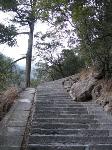
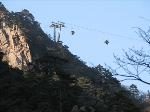
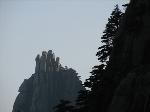
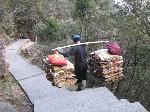
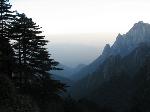
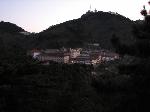
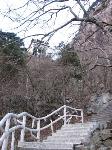
 Copyright © 1998-2025 All rights reserved.
Copyright © 1998-2025 All rights reserved.